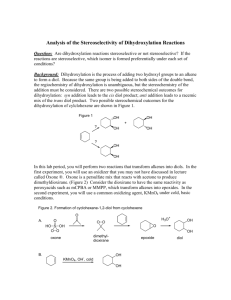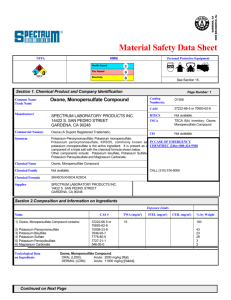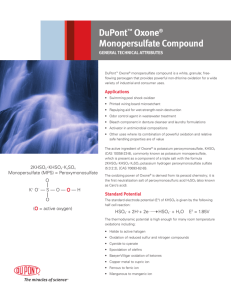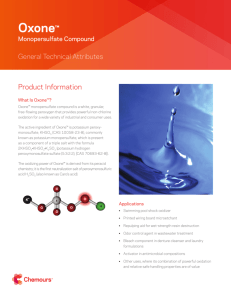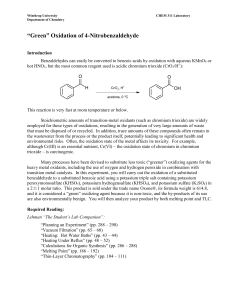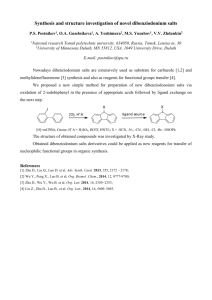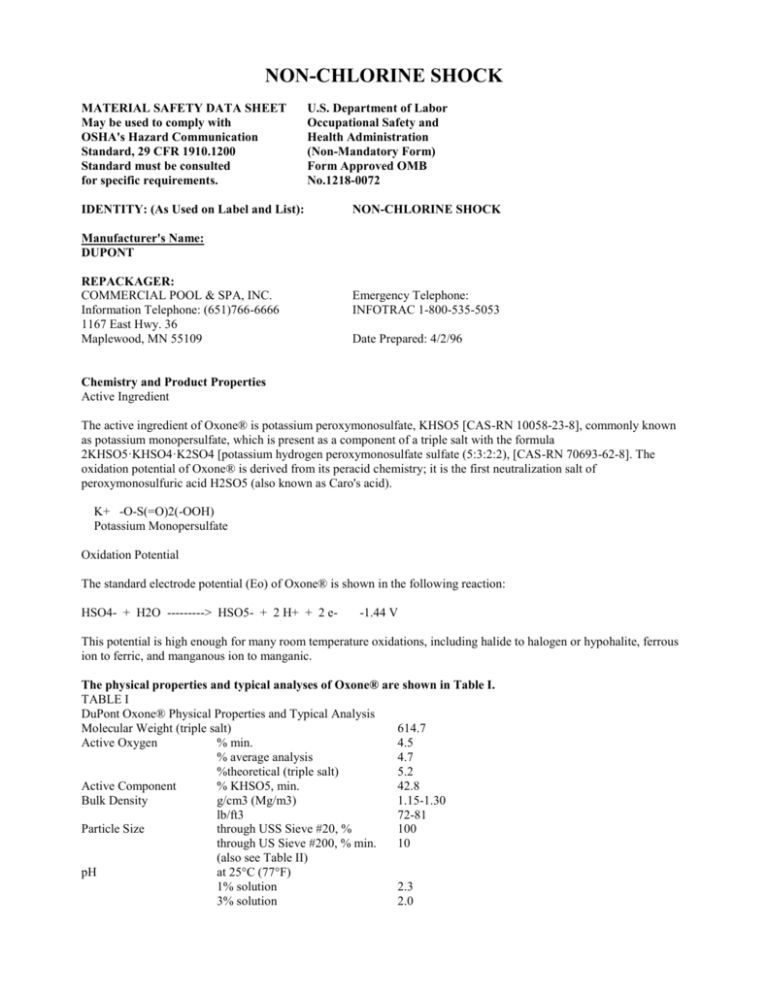
NON-CHLORINE SHOCK
MATERIAL SAFETY DATA SHEET
May be used to comply with
OSHA's Hazard Communication
Standard, 29 CFR 1910.1200
Standard must be consulted
for specific requirements.
U.S. Department of Labor
Occupational Safety and
Health Administration
(Non-Mandatory Form)
Form Approved OMB
No.1218-0072
IDENTITY: (As Used on Label and List):
NON-CHLORINE SHOCK
Manufacturer's Name:
DUPONT
REPACKAGER:
COMMERCIAL POOL & SPA, INC.
Information Telephone: (651)766-6666
1167 East Hwy. 36
Maplewood, MN 55109
Emergency Telephone:
INFOTRAC 1-800-535-5053
Date Prepared: 4/2/96
Chemistry and Product Properties
Active Ingredient
The active ingredient of Oxone® is potassium peroxymonosulfate, KHSO5 [CAS-RN 10058-23-8], commonly known
as potassium monopersulfate, which is present as a component of a triple salt with the formula
2KHSO5·KHSO4·K2SO4 [potassium hydrogen peroxymonosulfate sulfate (5:3:2:2), [CAS-RN 70693-62-8]. The
oxidation potential of Oxone® is derived from its peracid chemistry; it is the first neutralization salt of
peroxymonosulfuric acid H2SO5 (also known as Caro's acid).
K+ -O-S(=O)2(-OOH)
Potassium Monopersulfate
Oxidation Potential
The standard electrode potential (Eo) of Oxone® is shown in the following reaction:
HSO4- + H2O ---------> HSO5- + 2 H+ + 2 e-
-1.44 V
This potential is high enough for many room temperature oxidations, including halide to halogen or hypohalite, ferrous
ion to ferric, and manganous ion to manganic.
The physical properties and typical analyses of Oxone® are shown in Table I.
TABLE I
DuPont Oxone® Physical Properties and Typical Analysis
Molecular Weight (triple salt)
614.7
Active Oxygen
% min.
4.5
% average analysis
4.7
%theoretical (triple salt)
5.2
Active Component
% KHSO5, min.
42.8
Bulk Density
g/cm3 (Mg/m3)
1.15-1.30
lb/ft3
72-81
Particle Size
through USS Sieve #20, %
100
through US Sieve #200, % min.
10
(also see Table II)
pH
at 25°C (77°F)
1% solution
2.3
3% solution
2.0
Solubility
Moisture Content
Stability
Standard Electrode
Potential (Eo)
Heat of Decomposition
Thermal Conductivity
g/L, H2O, 20°C (68°F)
(also see Table III)
% max.
% active oxygen loss/month
V
256
kJ/kg
Btu/lb
W/m·K
Btu·ft/h·ft2·F
251
108
0.161
0.093
0.1
<1
-1.44
This Table shows typical properties based on historical production performance. DuPont does not make any express or
implied warranty that this product will continue to have these typical properties.
Stability
Oxone® is a relatively stable peroxygen, and loses less than 1% of its activity per month when stored under appropriate
conditions. However, like all other peroxygens, Oxone® undergoes very slow decomposition in storage, with liberation
of oxygen gas and a small amount of heat. Decomposition of Oxone® generates oxygen gas. If a decomposition is
associated with high temperature, decomposition of the constituent salts of Oxone® may generate sulfuric acid, sulfur
dioxide, or sulfur trioxide. The stability is reduced by the presence of small amounts of moisture, alkaline chemicals,
chemicals which contain water of hydration, transition metals in any form, and/or any material with which Oxone® can
react. The decomposition of Oxone® is exothermic; this property can cause the decomposition to accelerate if
conditions allow the product temperature to rise.
Solutions
Oxone® is highly and readily soluble in water as shown in Table III. At 20°C (68°F), the solubility of Oxone® in water
is >250 g/L.
At concentrations above saturation, potassium sulfate will precipitate, but additional potassium monopersulfate can
remain in solution, so that the attainable % active oxygen in solution is higher than is indicated in Table III.
Solutions of Oxone® are relatively stable when made up at the unmodified pH of the product. The stability is adversely
affected by higher pH, especially above pH 7. A point of minimum stability exists at pH 9, at which the concentration of
the mono-anion HSO5- is equal to that of the di-anion SO5=. Iron, cobalt, nickel, copper, manganese, and other
transition metal ions can catalyze the decomposition of Oxone® in solution; the degree to which catalysis occurs is
dependent on the concentrations of Oxone® and of the metal ion.
Storage of Oxone® Solutions
Solutions of Oxone® can be prepared readily because of its rapid and high solubility and are reasonably stable for up to
a few weeks if high quality water is used and if temperatures are kept low [preferably <25°C (77°F)]. Solutions should
be stored in vessels of appropriate materials of construction such as stainless steel or polyethylene. Vessels should be
loosely covered to avoid airborne contaminates, but should be vented to prevent pressure buildup. Upward adjustment
of the pH, any addition of a reactive or catalytic material, or an increase in temperature will decrease the stability of an
Oxone® solution.
Such solutions can be metered to a process as required. Equipment for dissolution of Oxone® from 25-kg bags or 1-t
(metric) bulk bags is available from DuPont; for further information see your Sales Representative or call 888-243-4608
(302-892-7575 outside the U.S. and Canada).
Safety and Handling
Personal Safety and First Aid
The Oxone® Material Safety Data Sheet (MSDS) provides additional information about the product, and should be
consulted before Oxone® is handled. Ask your Sales Representative or call 800-441-9340 for a copy of the MSDS.
Health Hazards
Oxone® has a low order of toxicity when taken internally, based on animal studies. The approximate lethal dose (ALD)
for rats is 2250 mg/kg. However, Oxone® should not be taken internally and should be considered harmful if
swallowed.
Oxone® is corrosive to the eyes, skin, nose, and throat due to its acidity and oxidizing properties, and may cause
allergic reactions in sensitive individuals. Temporary hair loss has been observed on contact with moist or sweaty skin.
DuPont observes an airborne exposure limit to Oxone® dust of 1 mg/m3, 8-hour time-weighted average.
Safety Precautions
Persons handling Oxone® should avoid contact with eyes, skin, or clothing. Avoid breathing dust. Wash thoroughly
after handling and launder contaminated clothing before re-use. Exposure to Oxone® can be minimized by providing
adequate ventilation and by wearing rubber- or plastic-coated gloves and chemical safety goggles.
Site Facilities
The following safety equipment should be easily accessible in all areas where Oxone® is handled or stored:
* Safety Showers with quick opening valves that stay open. Water should be supplied through insulated lines.
* Water Hydrant and Hose or other means of flushing spills with large volumes of water under low pressure.
* Eye Wash Fountains or other means for thoroughly washing the eyes with a gentle flow of clean water.
First Aid
In case of contact, immediately flush eyes with plenty of water for at least 15 min. Flush skin with water. If inhaled,
remove to fresh air. Call a physician.
Storage Conditions
Oxone® should be stored in cool, dry areas, away from combustible materials, incompatible chemicals, and sources of
heat such as space heaters and light fixtures. (see Incompatible Materials). Prolonged storage at ambient temperatures
greater than 32°C (90°F) should be avoided. Pallets of 25-kg bags can be stacked if there are 2-3 in of air space between
them; however, pallets should be stacked no more than two (2) high unless local fire codes permit higher stacking. Torn
bags and product spillage must be thoroughly cleaned up and removed from the area (see Waste Disposal).
Oxone® decomposition will be accelerated on contact with moisture. Product packaging includes a water-resistant liner,
but storage conditions should also include provisions for prevention of contact with water, including high airborne
humidity.
Mass Limitation
Like all other peroxygens, Oxone® undergoes very slow decomposition which liberates heat (heat of decomposition =
251 kJ/kg). The maximum mass of Oxone® during storage or processing at ambient temperature should never be
allowed to exceed a cube 122 cm (4 ft) on each side; this is equivalent to 1.81 m3 (64 ft3) or 2045 kg (4500 lb) of
Oxone®. Quantities in excess of this limit can trap heat or prevent heat dissipation, which can lead to runaway
decomposition with liberation of large amounts of oxygen, additional heat, and eventually to acidic fumes containing
SO2 or SO3 if the internal mass temperature exceeds 300°C (572°F). Storage silos, hoppers, processing vessels,
blenders, and other facilities must be designed to avoid quantities in excess of this limitation.
Incompatible Materials
Incompatible materials are those which can cause accelerated decomposition of Oxone® or which can react with
Oxone® to form undesirable products. While Oxone® might co-exist with such materials under ideal conditions, they
must be avoided to prevent serious consequences should unanticipated conditions occur (for example, inadvertent
contact with moisture).
The following are considered incompatible materials and should not be transported or stored in proximity to
Oxone®:
Compounds containing halides or active halogens. Oxone® can oxidize halides to active halogens (for example,
chloride to chlorine), and the acidity of Oxone® might react with an active halogen compound to release halogen gas.
* Cyanides, which can react with the acidity of Oxone® to release toxic hydrogen cyanide gas.
* Transition "heavy" metals (such as copper, manganese, cobalt, or nickel) or their salts, oxides, hydroxides, etc., can
accelerate the decomposition of Oxone® with evolution of oxygen gas.
* Readily oxidizable organic compounds.
Waste Disposal
Spillage, floor sweepings, and other waste Oxone® should be dissolved, diluted and disposed of in accordance with
Federal, State, and local regulations. Solutions of greater than 3% Oxone® will have a pH less than 2.0, and may be
considered RCRA hazardous due to the low pH. Neutralization with caustic soda or soda ash may be necessary before
flushing to waste treatment plant or sewer, if approved by authorities.
Spilled material must not be recycled to production.
Solid Oxone® waste, including dust from dust collectors or bag houses, must be collected in separate containers and
kept segregated from other materials.
Packaging and Shipping
Shipping Containers
Oxone® is available in 25-kg (55.1-lb) net multi-wall, moisture-resistant paper bags (42 per pallet), 12-kg repulpable
bags (80 per box), and 1-t (metric) (2205 lb) lined bulk bags.
Formulated mixtures containing Oxone® should always be protected by moisture barrier packaging.
Shipping Information
Proper Shipping Name = CORROSIVE, SOLID, ACIDIC, INORGANIC, N.O.S.
(MONOPERSULFATE COMPOUND)
Hazard Class = 8
UN Number = 3260
DOT/IMO Label = CORROSIVE
Packing Group = 2
Other jurisdictions may have additional requirements and designations.
Processing of Oxone®
Persons handling Oxone® should avoid contact with it (see Safety Precautions).
Home Applications
Technical Info
If you have questions or comments, please contact us by e-mail; by phone at DuPont Specialty Chemicals: 1-888-2434608 (302-892-7575 outside the U.S. and Canada); or by fax: 302-892-1456.
Copyright © 1998 E. I. du Pont de Nemours and Company. All rights reserved.

